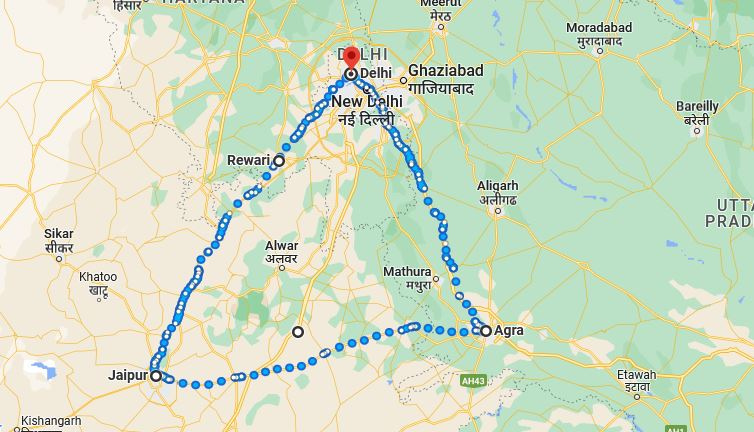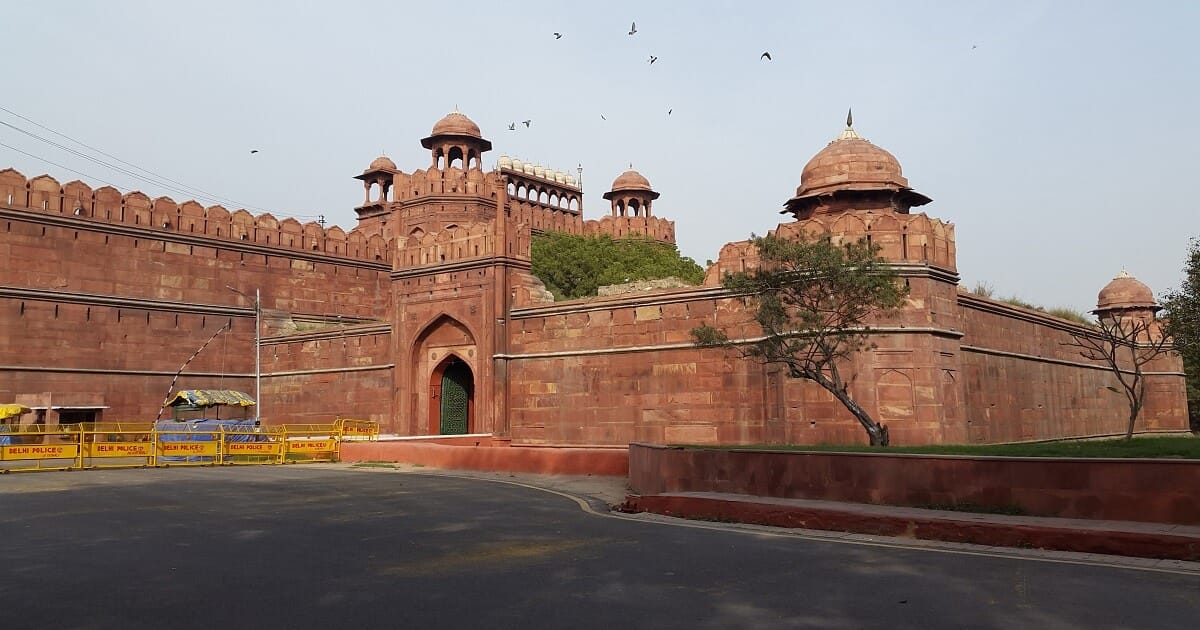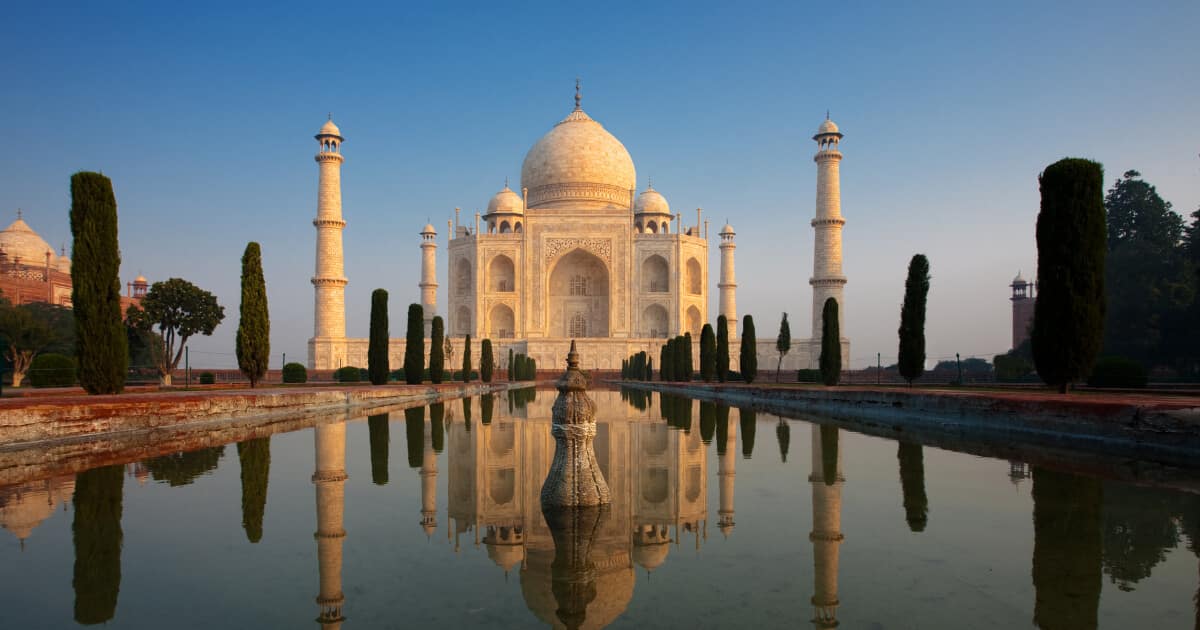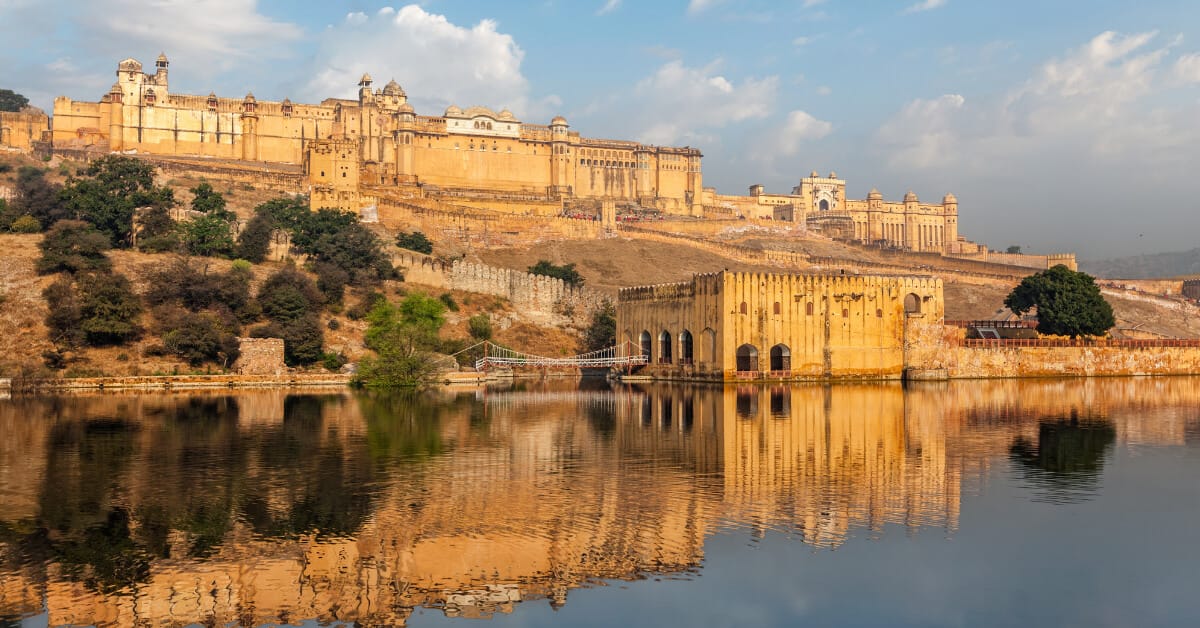Magnificent tradition, rich heritage, and diversity define India. Moreover, tourists from around the world visit India to relish its varied and captivating beauty. Among India’s most popular travel circuits, The Golden Triangle Tour represents a captivating tourist circuit. In addition, In this circuit, you will experience the wonders of architecture, centuries-old history, various traditions of people, various sculptures, crafts and various dishes that will help India to know widely. Now, you might be wondering, what exactly is the Golden Triangle Tour? So, you can read the blog to get information about Golden Triangle Tour 6 Days Itinerary.
What is the Golden Triangle Tour?
To begin with, The Golden Triangle Tour creates a journey circuit connecting three famous cities in India: Delhi, Agra and Jaipur. This route in the shape of a triangle spreads out all over the map. The beginning starts from India’s capital, Delhi, to Agra and Jaipur, one of India’s best tourist circuits. But why ‘Golden’? Because these three cities combine magnificent history, historical architecture, and spiritual significance. On the Golden Triangle Tour, you will see the history of Rajput, Mughal, Sultanate and British times and the wonders of their architecture.

An Overview of the Golden Triangle Tour:
Moving on, Golden Triangle Tour 6 Days Itinerary journey begins with the complete harmony of the old and new city in the capital of India, Delhi, which offers you the opportunity to peek into the age of mighty empires and grand dynasties. Ancient Mughal architecture, elegant colonial buildings, modern skyscrapers, narrow street markets and vibrant markets, and incredibly delicious street food cultures delight tourists.
This golden triangle tour leads to Agra, one of the world’s seven wonders. As you proceed, When we move from Delhi to the front, the magnificent Taj Mahal is located in this city. It is a white marble tomb built by Emperor Shah Jahan in memory of his beloved wife, Mumtaz Mahal. On the Golden Triangle tour, visitors get a glimpse of the symbol of love, the Taj Mahal. Along with this, Agra Fort and Fatehpur Sikri are essential places in Agra.
Furthermore, The next destination on the Golden Triangle Tour is Jaipur, famously known as the ‘Pink City’ for its charming pink-hued architecture. Jaipur is a symbol of the royal inheritance of the Rajput history of Rajasthan, which is its magnificent palaces, ancient castles and ancient but modern-coloured markets where you will be able to fit yourself in the colours and craftsmanship of local artisans. The beauty of the Aamer Fort, the glory of the City Palace and the wonderful of the Hawa Mahal are some diamonds of the invaluable treasures of this captivating city.
Golden Triangle Tour 6 Days Itinerary
Day 1: touchdown in Delhi
Highlights– Red Fort, Jama Masjid, India Gate, Chandni Chowk Bazar
Foody’s Corner– Chandi Chowk Lick and Jalebi and Parathe Wali Galli Recipes
Start your Golden Triangle Tour 6 Days Itinerary journey at the historic Red Fort, constructed in Mughal style from red sandstone by Shah Jahan in 1648. Next visit place is Jama Masjid. Jama Masjid is one of the largest mosques in India. It was built by Shah Jahan in 1658. This mosque is located in the middle of Chandni Chowk in Old Delhi. After a visit to the Jama Masjid, the nearby Chandni Chowk Bazaar is an excellent destination for shopping enthusiasts.

Chandni Chowk Bazaar stands as one of Delhi’s oldest and most renowned markets. Here, you remember to enjoy delicious dishes along with pocket-friendly shopping. Visit India Gate after shopping and enjoying delicacies from food stalls in Chandni Chowk. India Gate serves as a war memorial, so be sure to pay tribute to the martyrs. The lighting of India Gate looks beautiful at night, so people come to see this fantastic night view. The first day of the Delhi visit ends here. Overnight at a hotel in Delhi.

Day 2: More Delhi Exploring
Highlights– Akshardham Temple, Lotus Temple, Lakshmi Narayan Temple (Birla Temple), Qutub Minar, Humayun’s Tomb, Jantar Mantar, Shopping at Janpath Market
Foodies Corner– Connaught Place for multi-cuisine restaurants
On the second day of your journey, Combining spirituality with the morning peace energizes and makes your mind happy. So start the second day of Delhi visit with the Akshardham temple on the banks of the Yamuna. Akshardham means Abode of God. This Hindu temple of Swaminarayan Sampraday Akshardham Temple is dedicated to Lord Swaminarayan and the Hindu God. Hence, this place represents purity and peace. After visiting Akshardham Temple, visit Lotus Temple and Lakshmi Narayan Temple (Birla Temple). Then, visit the Qutub Minar, the tallest minar in India. The Qutub Minar premises have been included in the UNESCO World Heritage Site.

Afterwards, visit the UNESCO World Heritage Site Humayun’s Tomb. After admiring the beauty of the beautiful garden on the premises of Humayun’s mausoleum, visit the most beautiful Lodi garden in Delhi. Visit the Jantar Mantar Astronomical Observatory near Connaught Place in New Delhi after seeing different trees in Lodi Garden, including unique bonsai trees and numerous species of butterfly birds. Maharaja Sawai Jai Singh II of Jaipur built this astronomical observatory. Jantar Mantar Astronomical Observatory is used to find the shortest and longest days of the year, check the time and align the positions of the stars with the signs.

After exploring these historical and cultural landmarks, visit the nearby Janpath Market, where you can shop for leather goods, trendy clothes, jewellery and accessories, shoes, brassware, Indian artefacts, and handicrafts. End the day with dinner at Connaught Place, which offers dining options to suit your taste. Overnight at a hotel in Delhi.
Day 3: Delhi to Agra – The City of Love
Highlights– Taj Mahal, Agra Fort
Foodies Corner– Mughlai cuisine at local restaurants
Departing from Delhi and moving on, this Golden Triangle tour leads travellers to Agra, which will allow you to feel a different environment. Agra’s main attraction is the magnificent Taj Mahal, one of the World’s Seven Wonders. The Taj Mahal is a mausoleum located on the banks of the Yamuna River. The Taj Mahal was built by the Mughal Emperor Shah Jahan (reigned 1628–58) in memory of his inseparable companion Mumtaz Mahal.

White marble is the primary material used in crafting the Taj Mahal. The Taj Mahal is a masterpiece of Mughal architecture. It features a unique blend of Indian, Persian and Islamic architectural styles. The Taj Mahal is one of the iconic monuments of the Seven Wonders of the World. This exquisite architectural complex was designated a UNESCO World Heritage Site in 1983. The surrounding gardens, beautiful fountains and beautifully decorated trees in the Taj Mahal premises make the Taj Mahal very attractive. Visit the majestic Agra Fort after collecting memories of this unique architecture.
Agra Fort, also known as Red Fort Agra, is a massive fort constructed from red sandstone. The fort was established in 1565 by Mughal Emperor Akbar. Agra Fort was used as a royal residence, seat of government and military headquarters when the Mughal capital was in Agra. Designated as a UNESCO World Heritage Site in 1983, Agra Fort reflects the architectural splendour of the Mughal rule in India. Conclude your day by savoring the delicious flavors of Mughlai cuisine recall the Mughal era after visiting the fantastic architecture during the day. Overnight at a hotel in Agra.

Day 4: Agra to Jaipur – En Route Fatehpur Sikri
Highlights – Arrival at Fatehpur Sikri, Jaipur
Foodies Corner – Local Rajasthani Cuisine,
On the fourth day of your journey, en route to Jaipur, stop at Fatehpur Sikri, 40 km from Agra. Fatehpur Sikri, The red sandstone town, is a famous tourist attraction. Fatehpur Sikri was founded in 1571 century by Mughal Emperor Akbar. It is a fortified city and was the capital of the Mughal Empire for fifteen years. Fatehpur Sikri is a UNESCO World Heritage Site. This city presents you with stories of its glorious past.

After this visit, your next destination is Jaipur. Jaipur means “Pink City.” its colour and grandeur will mesmerize you. A significant portion of today’s journey involved traveling. Now, it is recommended to Enjoy a Rajasthani thali for dinner. It is a plate full of local dishes bursting with beautiful flavours and textures. Overnight at a hotel in Jaipur.
Day 5: Majestic Jaipur
Highlights – Shopping at Amer Fort, Jaigarh Fort, City Palace, Jal Mahal (Water Palace), Hawa Mahal, Johri Bazar
Foodie’s Corner – Local Rajasthani Thali on arrival, Wind View Cafe near Hawa Mahal
Today, your morning is in Jaipur, the capital city of Rajasthan. With its beautiful palaces and massive forts, this city always mesmerizes the tourists, and you will feel the same. Start your trip today with an elephant ride to Amer Fort or Amber Fort. Amer Fort is a vast, beautiful fort made of white marble with yellow and pink sandstone. Declared a UNESCO World Heritage Site in 2013,This beautiful Amer Fort is a fine example of Rajasthani architecture.

Continuing your exploration, visit nearby Jaigarh Fort. In this fort, you will see the world’s giant cannon on wheels called “Jaivana” (Jivana’s cannon) from the Rajput era. After visiting Jaigarh Fort, you should visit Jal Mahal (Water Palace). Jal Mahal ranks among the most photographed locations in Jaipur, so you should capture the beautiful memories of your trip here on camera. After that, you should visit Hawa Mahal, which is made of red and pink sandstone. After enjoying the beauty of Hawa Mahal, in the afternoon, visit Jaipur’s most famous place, City Palace Jaipur.

Next Place is The City Palace, Jaipur:
The City Palace, Jaipur, was earlier a royal residence and the ceremonial and administrative seat of the Maharaja of Jaipur. City Palace attractions include Chandra Mahal, Mukut Mahal, Sri Gobind Devji Temple, Maharani’s Palace, Mubarak Mahal, Pritam Niwas Chowk, Diwan-i-Aam, Diwan-i-Khas, Baggi Khana, and the City Palace Museum. A visit to City Palace Jaipur takes you on a journey through the rich history of Rajasthan. Just one stop will fill you with wonder, heritage, history and culture about the lives of the Kings and Queens of Jaipur.
Read More About – Best Places To Visit In Jaipur in Two Days: Top Attractions

After having these beautiful memories of the City Palace, visit the Jantar Mantar Astronomical Observatory. Before this, a Jantar Mantar astronomical observatory came to Delhi as well. There are 5 Jantar Mantar astronomical observatories in India built by Maharaja Sawai Jai Singh 2 of Jaipur, located in New Delhi, Jaipur, Ujjain, Varanasi and Mathura. Among these, Jantar-Mantar in Jaipur is the biggest.

Next Destination is Jaipur Crafts and Culture:–
To round off your day, After admiring the beauty of the forts and palaces of Jaipur during the day, you should go shopping in the local markets of Jaipur. Visit Johri Bazaar, the busy market near Hawa Mahal in the Pink City of Jaipur. In this bazaar, jewellery shops and shops with Rajasthani flair, Jaipuri quilts, Rajasthani turbans, groceries, bridal and bridal wear, precious stones and gems shops on both sides of the road. At Johari Bazar, you can shop to gift your loved one as a trip souvenir.
You can enjoy Rajasthani cuisine and shopping at the Johari Bazar at night. Here, you find shops serving delicacies like the age-old famous Lakshmi Mishtan Bhandar, Shree Shyam Chaat Bhandar, Narayanji Gajak Wale, Wind View Cafe near Hawa Mahal, and Hotel Sweet Dream Restaurant, which you should take advantage of. Overnight at a hotel in Jaipur.
Read More About – Top must visit shopping destinations in Jaipur
Day 6: Farewell of Golden Triangle Tour, For Now
On your final day of Golden Triangle Tour 6 Days Itinerary plan is your day to enjoy any remaining moments. If you have to catch your flight home from Jaipur, then after breakfast this morning, you can visit Birla Mandir and the famous Monkey Temple (Galta Ji). If you want to catch a flight home from Delhi, you should see a flight from Jaipur to Delhi after breakfast. Leave time for the rest of the sightseeing and shopping in Delhi before catching your flight home.

In conclusion, this expedition guides you across the captivating diversity, rich history, and tantalizing flavours of India’s Golden Triangle.! Lastly,This Golden Triangle 6 Day tour isn’t merely a vacation; it’s an experience that will leave a lasting imprint on your soul. So, what are you waiting for? Pack your bags and embark on an adventure that promises to be golden!
Until next time, keep wandering and wondering!

